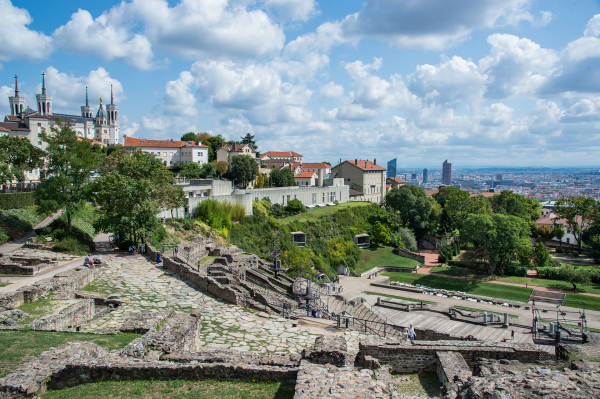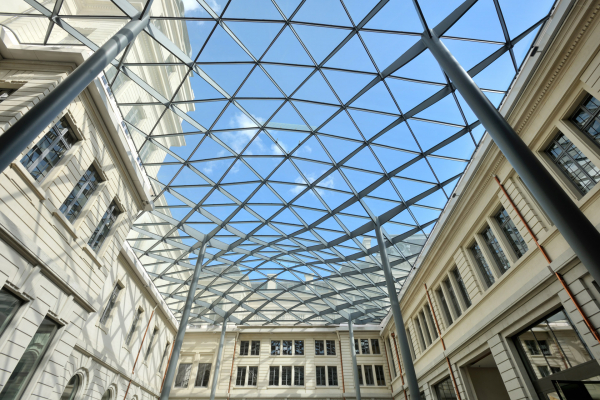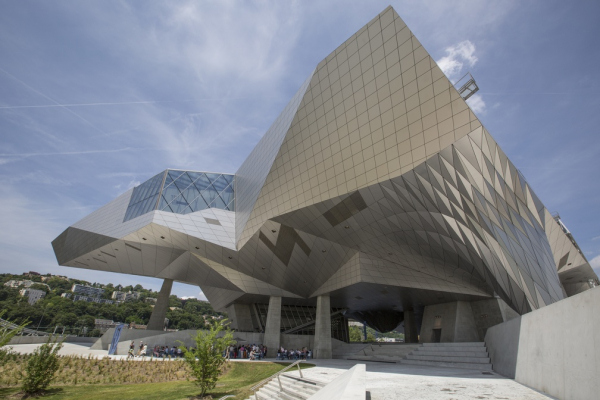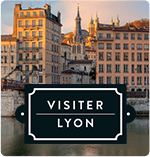An urban stroll through history
Lyon gives its visitors an exceptional historical trail. In the Jardin des Curiosités, time unfolds from past to present, and from east to west. Here visitors can stroll from antiquity to modern-day life via the Renaissance period, thus gaining an understanding of over two centuries of architectural heritage; which explains why 500 ha of the city are inscribed on UNESCO's world heritage list.
The age-old Fourvière hill
It is on the "hill that prays" that Lucius Munatius Plancus founded Lugdunum, the capital of the Gauls, in the year 43 BC. Here lies one of the most imposing archaeological ensembles from antiquity, including an Odeon and a theatre, which could seat up to 10,000 people. The neighbouring Gallo-Roman museum draws visitors into a spiral that goes back in time, for an interactive discovery tour of five centuries of archaeological treasures. Here you will be told that a shrine was built on the ruins of the Roman forum as early as the 12th century. Both chapels, one of which was devoted to the Virgin Mary, were to become in the 19th century the Fourvière Basilica designed by Pierre Bossan, now symbolic of the city itself. Nowadays, the hill is also a temple devoted to music and live shows, thanks to Les Nuits de Fourvière during summer evenings.
Vieux-Lyon, a unique Renaissance district in Europe
At the foot of Fourvière hill, Vieux-Lyon is one of the largest Renaissance ensembles in Europe. Surrounding the three spires of St-Georges, St-Jean and St-Paul, the 24 ha district was protected by the Malraux law in 1964. Ever since, authorities have been busy renovating this pedestrian area listed by UNESCO in 1998. An object of particular attention, traboules are intersecting alleyways in Vieux-Lyon, and a cu¬riosity specific to the city. These 300 pedestrian passageways are used to go from one street to another, through the inner courtyards of buildings.
The well-kept secret of Lyon's traboules !
The "Traboules" application devised by ONLYLYON Tourism reveals the secrets of Lyon's famous courtyards and traboules. Thanks to augmented reality, this application immerses visitors in the Renaissance period and the revolts of the Canut silk workers.
The Presqu’île, the heart of the City
A stroll through the Presqu’île spans 900 years of history. It begins with Rue Mercière, where the narrow alleyways and paving stones are reminiscent of the Middle Ages. In Place des Terreaux, visitors are immersed in the 17th century with the Hôtel de Ville and Palais Saint-Pierre opposite Bartholdi fountain. In Bellecour, they discover the huge square in honour of King Louis XIV. On Rue de la République, they can admire the Napoleonic style of the banking quarter, and the lovely Palais de la Bourse (Second Empire). And finally the modern touches of the Presqu’île: the roof of the Opera designed by Jean Nouvel and the columns designed by Buren in Place des Terreaux. Further south, they'll be given a taste of the future by strolling through the 150 ha Confluence site.
La Croix-Rousse, the "hill that works"
Croix-Rousse is like a village in the heart of the city. As everywhere else in Lyon, Roman remains are very present, but it is the "workshop" buildings, with their large windows and high ceilings that are so characteristic in this district. These homes were constructed around the large Jacquard weaving looms used by the silk workers, or Canuts, when the Croix-Rousse plateau was incorporated into Lyon in 1852. To get to this plateau, you have to navigate the pentes (slopes), a maze of alleyways, courtyards and traboules reminiscent of Vieux-Lyon.
Nowadays, the noise of the bistanclacs is more rarely heard, and the stores of young designers are multiplying and giving the district a facelift. Near the Saône, Les Subsistances has taken over the former Saint Marie des Chaînes convent. Now an artists' residence and home to the School of Fine Arts, it is also host to alternative events such as Les Nuits Sonores. The pentes are hip, trendy and innovative, a perfect illustration of tradition revisited.
The origin of "traboules" in the slopes of the Croix Rousse district
The silk manufactured on the Croix-Rousse plateau by the Canuts was loaded onto boats waiting on the Saône, at the bottom of the slope ("pentes"), to be sold. As silk was sold by weight, traders used the traboules to ensure the fabric stayed dry, so that it could be sold at its true value.
Lyon, a contemporary city
To the north of Lyon, the Cité Internationale, designed by Renzo Piano and completed in 2006, is a turning point of architectural renewal in the city. This district prefigures the focus on sustainability in future urban development in Lyon, as does the Confluence district south of the Presqu’île. As early as 2003, this district's 150 ha began to evolve, with the rehabilitation of the former buildings in Rambaud Port (Customs house, "Les Salins", "La Sucrière"). In this eco-friendly district, architects are remoulding the city: modern, colourful and in the vanguard, as with the orange Cube by Jakob and MacFarlane and the Musée des Confluences by Coop Himmelb(l)au.
In Part-Dieu, the 2nd largest business centre after La Défense in Paris, Lyon's skyline is being built up around the "Crayon", the Oxygène and Incity towers.
Finally, in Givors, Les Etoiles by Jean Renaudie were awarded the 20th Century Heritage label in 2003. This geometric, star-shaped district is one of the Utopies Réalisées (Utopia Achieved). As are the sky-scrappers in Villeurbanne, considered ultra-modern architectural ensembles at the time, that provided both social housing and community facilities.




